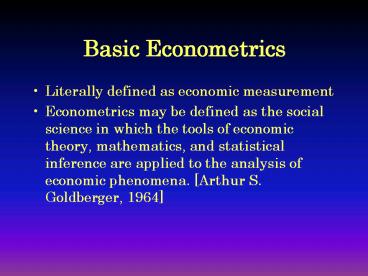Basic Econometrics PowerPoint PPT Presentation
1 / 10
Title: Basic Econometrics
1
Basic Econometrics
- Literally defined as economic measurement
- Econometrics may be defined as the social science
in which the tools of economic theory,
mathematics, and statistical inference are
applied to the analysis of economic phenomena.
Arthur S. Goldberger, 1964
2
Ordinary Least Squares
- Ordinary Least Squares a statistical method that
chooses the regression line by minimizing the
squared distance between the points and the line. - i.e. minimize the sum of S, where S ?e2
- where e the distance between the line and the
point, or the error term. - Error term (e) random, included because we do
not expect a perfect relationship. - Why not sum the errors? Generally equals zero
- Why not take the absolute value of the errors? We
wish to emphasize large errors.
3
Source of Error
- Omitted variables
- Measurement error
- Incorrect functional form
4
Univariate Analysis
- Y a bX Where
- Y The Dependent Variable, or what you are
trying to explain (or predict). - X The Independent Variable, or what you believe
explains Y. - a the y-intercept or constant term.
- b the slope or coefficient
5
The t-statistic
- To evaluate the quality of our slope coefficient
we refer to the - t-statistic.
- T-statistic slope coefficient / standard error
- Standard error - estimated standard deviation of
the coefficient - Rule of thumb T-stat gt 2
- Why? We want to know whether or not the
coefficient is statistically different from zero. - The t-statistic is used to test the null
hypothesis (H0) that the coefficient is equal to
zero. The alternative hypothesis (HA) is that the
coefficient is different than zero.
6
The slope coefficient
- How do we interpret the slope coefficient?
- Example
- Wins -0.1508 0.0063PTS per game
- Each additional one point per game results in a
0.0063 increase in winning percentage. - How many wins is this? 0.513 over an 82 game
season. - Is this the truth? We never know the truth, we
are simply attempting to derive estimates. - Is this a good estimate? Clearly points alone
do not explain wins.
7
The constant term
- How do we interpret the constant term?
- The constant term must be included in the
regression, or else we are forcing the regression
line through zero. - The constant term is used to impose a zero mean
for the error term, hence it acts as a garbage
collector. In other words, it captures all the
factors not explicitly utilized in the equation. - The constant term is theoretically the value of Y
when X is zero. Frequently this is outside the
range of possibility, and therefore the constant
term should not be interpreted.
8
Multivariate Analysis
- Introducing the idea of ceteris paribus.
- One cannot impose ceteris paribus unless all
relevant variables are included in the model. - Wins a b(ORB)
- As illustrated earlier, the estimated impact of
offensive rebounds (ORB) on wins is negative. - In other words, b lt 0
- Wins c d(Missed Shots)
- The value of d lt 0
- ORB e f(Missed Shots)
- the value of f gt 0
- In other words, missed shots and offensive
rebounds are positively related. So when we
estimate wins as a function of offensive
rebounds, we are simply picking up the
relationship between wins and missed shots.
9
R-squared
- How do we know how accurate our equation is?
- R-squared Explained Sum of Squares / Total Sum
of Squares - Total sum of squares Sum of the squared
difference between the actual Y and the mean of
Y, or, - TSS ?(Yi - mean of Y)2
- Explained sum of squares Sum of the squared
differences between the predicted Y and the mean
of Y, or, - ESS ?(Y - mean of Y)2
- Residual sum of squares Sum of the squared
differences between the actual Y and the
predicted Y, or, - RSS ? e2
- The coefficient of determination Ratio of the
explained sum of squares to the total sum of
squares. (Provide example) - R2 ESS/TSS R2 1 - RSS/TSS
- 1 - ? e2 / ? (Yi - mean of Y)2
10
Adjusted R-Squared
- Adding any independent variable will increase R2.
To combat this problem,we often report the
adjusted R2. - Adjusted R2 1 - RSS/(n-K-1) / TSS/(n-1)
- where n observations
- K number of coefficients

